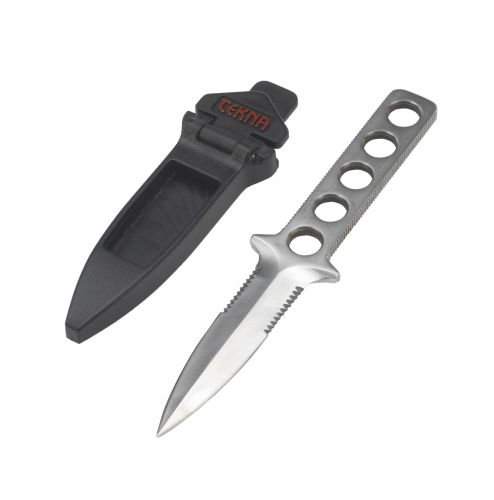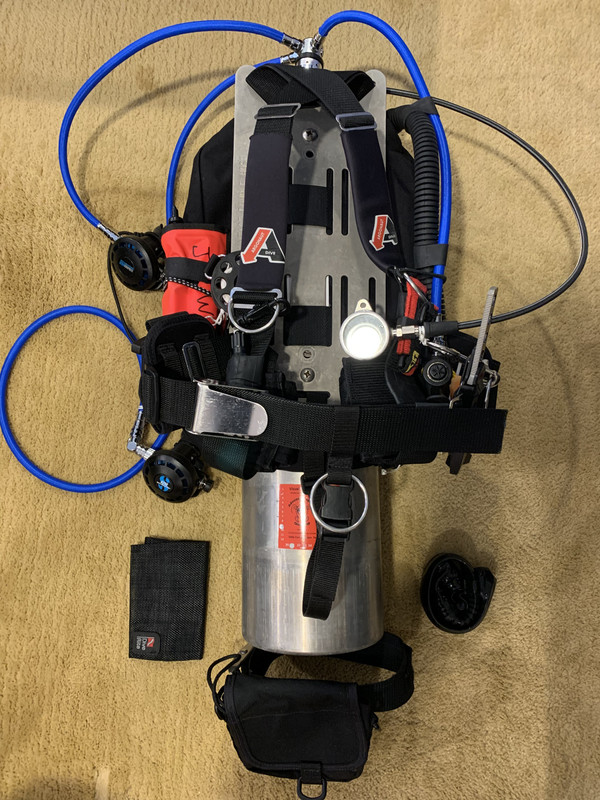You are using an out of date browser. It may not display this or other websites correctly.
You should upgrade or use an alternative browser.
You should upgrade or use an alternative browser.
Dive Knife Material vs. Corrosion: Titanium, H1, LC200N
- Thread starter drrich2
- Start date
Please register or login
Welcome to ScubaBoard, the world's largest scuba diving community. Registration is not required to read the forums, but we encourage you to join. Joining has its benefits and enables you to participate in the discussions.
Benefits of registering include
- Ability to post and comment on topics and discussions.
- A Free photo gallery to share your dive photos with the world.
- You can make this box go away
My problem with shears is that the pin/rivet is not dependable and the blades themselves are flimsy. Trauma shears are made for cutting fabric. I saw them being used by the EMT who cut my vintage, irreplaceable Scot Tinly Tri-Shorts off my body when I busted my femur. And they zipped through my shorts with ease! Much to my various protests, they were quite effective. But the few times I have used them underwater the pin has snapped or the blades bent. The pin rusts and I guess I should have inspected them and replaced them more frequently. I put a screw and nut though one stainless pair and then ground the fastener down and peened it. But still, when the cordage to be cut is particularly tough the blades go wonky. Anyways, I have gone back to my Tekna knives and a Trilobyte type line cutter. I have four Tekna knives, three stainless and one titanium.
Tekna Knife, originally introduced by the Tekna Company, a forward thinking SCUBA equipment manufactuer of the later 70s and 80s and they along with Farallon are long gone. But some of their items are still manufactured and there are also copies (China?) on the eBay. These are real:

And perhaps easier:
Still, however, I am open to shears, but I want something a little more dive than ambulance oriented.
The Tekna knife is NOT a BFK. It is a medium size knife and available in several configurations. One of mine with Ecozilla for scale:

I wear my Tekna knives on my waist belt but it can be fitted to the leg or arm as well. You can see it on my LH waist harness strap here:

And here:

James
Tekna Knife, originally introduced by the Tekna Company, a forward thinking SCUBA equipment manufactuer of the later 70s and 80s and they along with Farallon are long gone. But some of their items are still manufactured and there are also copies (China?) on the eBay. These are real:

Tektite: Tekna Ocean Edge Dive Knife, TEKNA Knives, TEK-OE
Tektite Technical,LZ,DZ,&IR Runway Lights & Beacons,Spec Ops & Dive LED Flashlights,Bulbs,strobes&beacons,Submarine Escape&UW EOD lights,UV&CSI Lights,&Knives
www.tek-tite.com
And perhaps easier:
Still, however, I am open to shears, but I want something a little more dive than ambulance oriented.
The Tekna knife is NOT a BFK. It is a medium size knife and available in several configurations. One of mine with Ecozilla for scale:

I wear my Tekna knives on my waist belt but it can be fitted to the leg or arm as well. You can see it on my LH waist harness strap here:

And here:

James
That's a good point, shears have a failure mode that a knife doesn't have.
I never have had that issue, I have cut someone out of a dry suit (including the zipper) with mine, as well as other tough material. But of course, that's just my limited experience.
If there is a problem with the pin corroding or the shears just overall getting old, even the best versions of these are so cheap, that there is no reason not to just replace them. I probably spend more on sorb per dive than I would replacing the shears every few weeks!
And again, I think that a trilobite is a reasonable backup for the shears for addressing ENTANGLEMENT issues, which is the reason why cutting devices are a general diving recommendation. This is almost always either fishing line or a diver's own reel line, not 1" heavy rope.
I just worry too much about the combination of underwater panic, the need for externally directed force and a sharp, pointy, heavy tool to feel that a knife is a good general recommendation for the average diver. Remember, in an entanglement situation, there may not be the clear, calm, deliberate actions that you might use clearing a prop shaft.
Maybe I'm klutzy, but I did have the experience of trying to find a tetanus shot in Cozumel many years ago after I tried to use a dive knife to remove a tank light zip tie!
I never have had that issue, I have cut someone out of a dry suit (including the zipper) with mine, as well as other tough material. But of course, that's just my limited experience.
If there is a problem with the pin corroding or the shears just overall getting old, even the best versions of these are so cheap, that there is no reason not to just replace them. I probably spend more on sorb per dive than I would replacing the shears every few weeks!
And again, I think that a trilobite is a reasonable backup for the shears for addressing ENTANGLEMENT issues, which is the reason why cutting devices are a general diving recommendation. This is almost always either fishing line or a diver's own reel line, not 1" heavy rope.
I just worry too much about the combination of underwater panic, the need for externally directed force and a sharp, pointy, heavy tool to feel that a knife is a good general recommendation for the average diver. Remember, in an entanglement situation, there may not be the clear, calm, deliberate actions that you might use clearing a prop shaft.
Maybe I'm klutzy, but I did have the experience of trying to find a tetanus shot in Cozumel many years ago after I tried to use a dive knife to remove a tank light zip tie!
vjb.knife1
Contributor
I am fairly sure that cutting 1" and larger rope made of copolyolefin rope and similar marine grade materials is a task that shears would not be suited for. My knives are always kept at a very sharp readiness, which my coworkers will attest to. They all give me their knives to sharpen. I use a device called the "wicked edge" sharpener and when I am done with it the shrpened portion of the knife edge has a mirror polish. You can pretty much just lay it onto something and it will cut it. I have been tangled in quite a few different things in my career and never had a problem getting out of it. I am not saying that shears or trilobites don't have a purpose or a place where they excell but they do have practical limits, and shear need a bit of extra care cleaning and lubing that some divers don't provide them. Now, if you want shears that will hold up to tough use I suggest the Leatherman Raptor series. They are not cheap but they are as heavy duty as it gets. I have not used them underwater yet but they have handled some pretty tough tasks around the dock. They also have a line cutter hook. These would require extra rinsing and lubrication. And they fold up and fit into a plastic carrier.


Hehe... that sounds pretty good for sushi, not sure that would be the best tool for a panicked diver trying to cut line entangling him, especially if he couldn't see where he was cutting!My knives are always kept at a very sharp readiness, which my coworkers will attest to. They all give me their knives to sharpen. I use a device called the "wicked edge" sharpener and when I am done with it the shrpened portion of the knife edge has a mirror polish. You can pretty much just lay it onto something and it will cut it.
I am fairly sure that cutting 1" and larger rope made of copolyolefin rope and similar marine grade materials is a task that shears would not be suited for.
Agreed, our weapon of choice for cutting hawser and towline wrapped around prop shafts was fine tooth hacksaw blades. Sharp knives are better when the line is loose or not under that much tension.
Large line isn't much of an entanglement issue in the grand scheme of recreational diving. Small line is the main concern, especially hard to see monofilament, and is the main reason to carry cutting tools that are not also being used for other purposes — like braining fish or collecting rock scallops.
This^Large line isn't much of an entanglement issue in the grand scheme of recreational diving. Small line is the main concern, especially hard to see monofilament, and is the main reason to carry cutting tools that are not also being used for other purposes — like braining fish or collecting rock scallops.
Similar threads
- Replies
- 130
- Views
- 9,471
- Replies
- 4
- Views
- 671
- Replies
- 50
- Views
- 3,094
- Replies
- 47
- Views
- 5,976



